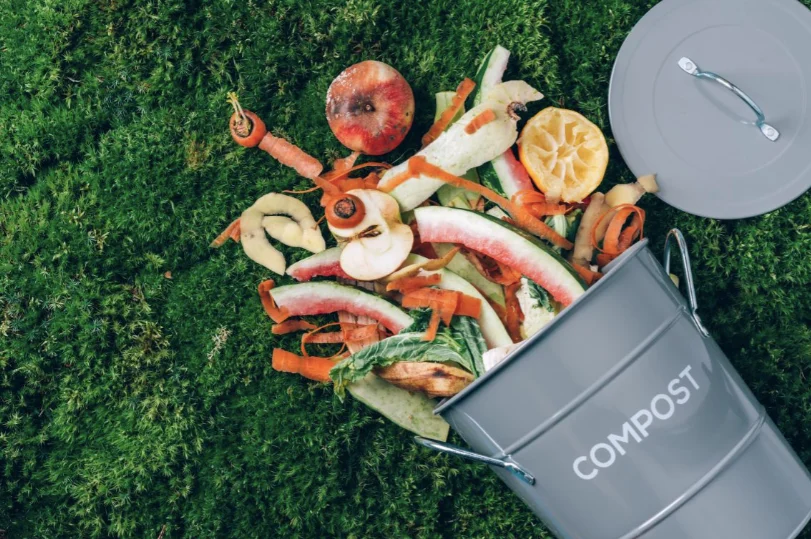Every day, countless banana peels, coffee grounds, eggshells, and vegetable scraps get tossed into the trash. But what if you could take that so-called “waste” and turn it into something valuable? That’s the magic of composting — transforming your everyday kitchen scraps into nutrient-rich compost, often referred to as soil gold.
If you’ve ever wanted to reduce waste, improve your garden, and make a real impact from your own kitchen, this post is for you.

🌿 What Is “Soil Gold”?
“Soil gold” is a gardener’s nickname for compost — the rich, dark, crumbly material produced when organic matter like food scraps and yard waste naturally decomposes. It’s packed with nutrients, improves soil structure, helps retain moisture, and supports healthy root systems. In other words, it’s one of the best things you can add to your garden soil.
But you don’t have to buy compost in bags. You can make it at home using the stuff you were already going to throw away.
🥕 Why Kitchen Scraps Are Perfect for Composting
Your kitchen produces some of the best materials for compost. Vegetable peelings, fruit rinds, coffee grounds, eggshells, and even used tea bags (the plastic-free kind) are full of nutrients that microbes and worms love to break down.
Instead of sending these materials to the landfill, where they’ll sit without air and contribute to methane gas production, you can use them to build healthier soil, naturally and sustainably.
🧺 How to Start Composting Kitchen Scraps
Starting a compost system at home is easier than it sounds. Here’s a step-by-step overview:
1. Collect Your Scraps
Keep a small container or pail in your kitchen to collect scraps throughout the day. Make sure it has a lid to help contain any smells and prevent fruit flies. Stainless steel bins, ceramic crocks, or even a simple repurposed Tupperware container will do the trick.
2. Know What to Add
Not all kitchen waste is compost-friendly. Stick to plant-based materials and avoid anything that can attract pests or slow down the composting process.
Great to Compost:
-
Vegetable and fruit scraps
-
Coffee grounds and filters
-
Crushed eggshells
-
Tea leaves (check your tea bags for plastic)
-
Bread (in small amounts)
Avoid:
-
Meat, bones, dairy, and oily foods
-
Citrus peels in large amounts (they take a while to break down)
-
Anything synthetic or coated in plastic
3. Balance It Out with Browns
Kitchen scraps are considered “greens” — they’re nitrogen-rich and moist. To compost effectively, you’ll need to balance them with “browns,” or carbon-rich materials like:
-
Shredded newspaper
-
Cardboard
-
Dry leaves
-
Paper towels (food-free)
-
Sawdust (from untreated wood)
A good rule of thumb: 2 parts brown to 1 part green by volume. This helps keep your compost from becoming smelly or slimy.
4. Choose Your Composting Method
Depending on your space, there are a few ways to compost kitchen scraps:
-
Outdoor Bin or Pile: If you have a backyard, designate a shady corner for composting. You can use a simple open pile or invest in a covered bin or tumbler.
-
Worm Bin (Vermicomposting): If you’re tight on space, a worm bin is a great indoor option. Red wigglers break down food scraps quickly and produce “worm castings” — a supercharged form of compost.
-
Bokashi Bucket: This method ferments your food waste (including meat and dairy!) in an airtight container with the help of special microbes. It’s great for apartments or small kitchens.
-
Electric Composters: These countertop gadgets grind and heat your food scraps into compost-like material in just a few hours. They’re ideal for modern, low-effort composting.
⏳ How Long Does It Take?
Depending on your method and how often you tend your compost, it can take anywhere from a few weeks to a few months to fully break down.
Hot compost piles (outdoors, turned frequently) can finish in 4–8 weeks.
Cold composting (low maintenance, slower process) may take 6 months to a year.
Worm bins typically produce usable compost in 2–3 months.
You’ll know it’s ready when it’s dark, crumbly, and smells like fresh earth.
🌻 Using Your Finished Compost
Once your compost is done, you can use it just about anywhere:
-
Mix it into garden beds to enrich the soil.
-
Add it to potted plants to give them a nutrient boost.
-
Sprinkle it on your lawn to promote thick, green growth.
-
Use it as a top dressing for trees and shrubs.
Think of it as a slow-release natural fertilizer that improves your soil every time you use it.
🌎 A Small Habit, A Big Impact
Composting kitchen scraps is more than just a gardening hack — it’s a way to live more sustainably. In the U.S. alone, food waste makes up nearly 30% of what we throw away. By composting, you’re keeping organic material out of landfills, reducing greenhouse gas emissions, and creating something truly beneficial in return.
It’s a simple shift that can make a big difference — for your garden, your wallet, and the planet.
Final Thoughts
Turning kitchen scraps into soil gold doesn’t require fancy tools or a green thumb. All you need is a bit of knowledge, a commitment to waste less, and the willingness to let nature do its work.
Start with your next banana peel. Add a few leaves or some shredded paper. Give it time, and soon you’ll have rich, living compost — straight from your kitchen.
